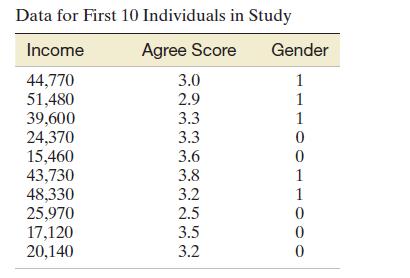Agreeableness, gender, and wages. Do agreeable individuals get paid less, on average, than those who are less
Question:
Agreeableness, gender, and wages. Do agreeable individuals get paid less, on average, than those who are less agreeable on the job? And is this gap greater for males than for females? These questions were addressed in the Journal of Personality and Social Psychology (Feb.
2012). Several variables were measured for each in a sample of individuals enrolled in the National Survey of Midlife Development in the United States. Three of these variables are: (1) level of agreeableness score (where higher scores indicate a greater level of agreeableness),
(2) gender (male or female), and (3) annual income (dollars).
The researchers modeled mean income, E(y), as a function of both agreeableness score (x1) and a dummy variable for gender 1x2 = 1 if male, 0 if female2. Data for a sample of 100 individuals (simulated, based on information provided in the study) are saved in the WAGAP file. The first 10 observations are listed in the accompanying table.
a. Consider the model E1y2 = b0 + b1x1 + b2x2. The researchers theorize that for either gender, income will decrease as agreeableness score increases. If this theory is true, what is the expected sign of b1 in the model?
b. The researchers also theorize that the rate of decrease of income with agreeableness score will be steeper for males than for females (i.e., the income gap between males and females will be greater the less agreeable the individuals are). Can this theory be tested using the model, part a? Explain.
c. Consider the interaction model E1y2 = b0 + b1x1 +
b2x2 + b3x1x2. If the theory, part
b, is true, give the expected sign of b1 and the expected sign of b3.
d. Fit the model, part
c, to the sample data. Check the signs of the estimated b coefficients. How do they compare to the expected values, part c?
e. Refer to the interaction model, part
c. Give the null and alternative hypotheses for testing whether the rate of decrease of income with agreeableness score is steeper for males than for females.
f. Conduct the test, part
e. Use a = .05. Is the researchers’
theory supported?
Step by Step Answer:

Statistics Plus New Mylab Statistics With Pearson Etext Access Card Package
ISBN: 978-0134090436
13th Edition
Authors: James Mcclave ,Terry Sincich






